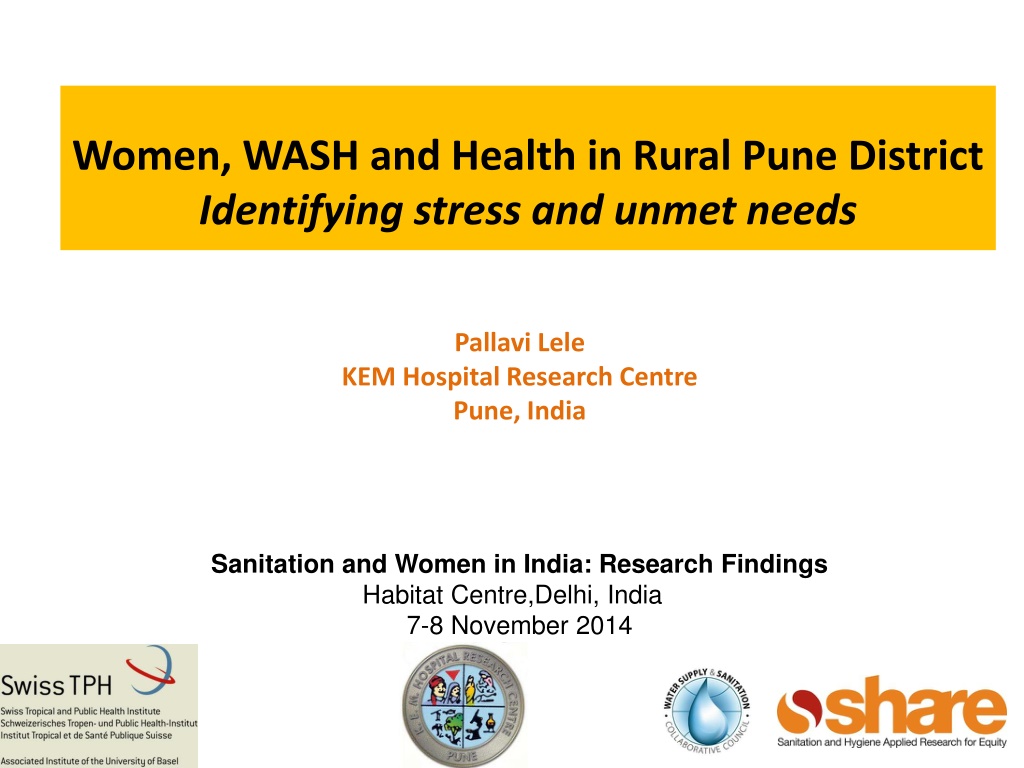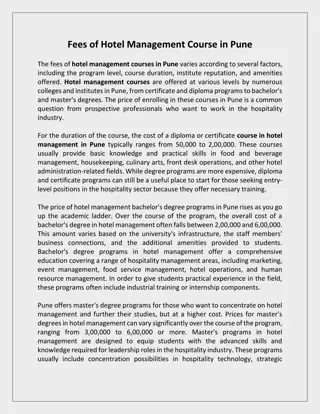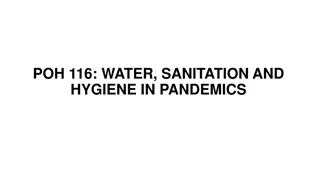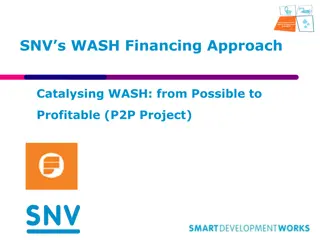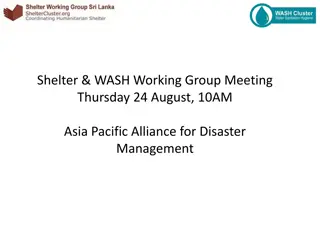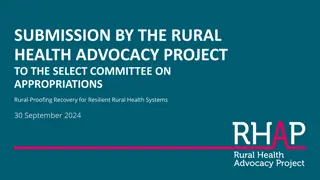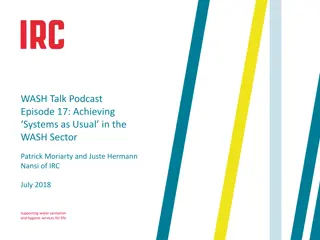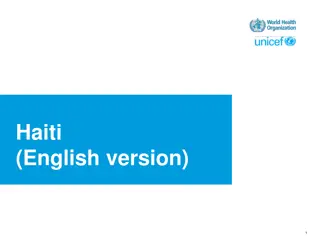Women, WASH, and Health in Rural Pune District
Examining the impact of inadequate sanitation facilities on women and girls in rural Pune district, this research discusses challenges such as limited toilet access, poor hygiene practices, and cultural taboos surrounding menstruation. The study highlights the links between water, sanitation, and health outcomes, emphasizing the need for comprehensive interventions to address these issues.
Download Presentation

Please find below an Image/Link to download the presentation.
The content on the website is provided AS IS for your information and personal use only. It may not be sold, licensed, or shared on other websites without obtaining consent from the author.If you encounter any issues during the download, it is possible that the publisher has removed the file from their server.
You are allowed to download the files provided on this website for personal or commercial use, subject to the condition that they are used lawfully. All files are the property of their respective owners.
The content on the website is provided AS IS for your information and personal use only. It may not be sold, licensed, or shared on other websites without obtaining consent from the author.
E N D
Presentation Transcript
Women, WASH and Health in Rural Pune District Identifying stress and unmet needs Pallavi Lele KEM Hospital Research Centre Pune, India Sanitation and Women in India: Research Findings Habitat Centre,Delhi, India 7-8 November 2014
Too few toilets for too many people Indicated failure to apply expertise Household coverage with cell phones 59% compared with 47% with toilets (Census 2011) Many schools fail to comply with requirements for toilets Medical facilities lack adequate sanitation facilities Mars landing: contradiction between high-tech capacity and limited attention to basic needs, incl. sanitation
The Hindu, Chennai, 14 Mar 2013. See also, Chambers R and von Medeazza G. Sanitation and stunting in India: undernutrition s blind spot. Econ Pol Weekly 22 Jun 2013.
Health and Gender-related impact Health Diarrheal diseases Stunting Psychosocial stress from limited (access to) facilities Gender-related Vulnerability to violence and victimization Cultural meaning and social restrictions of menstruation Burden of culturally mandated modesty
Request for Proposals : The effects of poor sanitation on women and girls in India Response Collaboration between: KEM Hospital Research Centre Pune s field site Vadu Rural Health Program in India (KEMHRC) and Swiss Tropical and Public Health Institute, Basel, Switzerland (Swiss TPH)
Conceptual framework of research plan Defecation-urination Nutrition-hydration Menstruation Basic needs Toilets and fields Water and food Absorbent materials Facilities and resources Personal prior experience Family and community experience and expectations Social and cultural values Use-mitigating factors WASH-related behaviour Indicated adjustments to dietary and fluid intake Menstrual hygiene Practice Self-perceived health problems or benefits of reported practice Psychosocial effects: personal, family and community Health impact
Aims 1. Identify sources of psychosocial stress with reference to personal experience, reported accounts and perceived vulnerability to violence that affect access and use of various types of sanitation facilities and open defecation. Identify women s preferences, priorities, practices and perceived needs regarding menstrual hygiene, distinguishing preferred and available options, assessing the stress imposed by social expectations and cultural values and clarifying perceived effects on women s health. Assess the level of stress, priority and self-perceived effects of limited access to water and sanitary facilities, and the extent to which such concerns may lead to coping strategies that involve limiting intake of food and liquids. Determine the availability, functionality and perceived adequacy of sanitary infrastructure in local health facilities, with particular attention to those facilities providing prenatal and obstetric care. Clarify whether these concerns influence the preference and use of accessible health facilities. 2. 3. 4.
Methods Sample No. Research Method 1. Quantitative Research a. 150 adolescents (13-17 years) b. 150 adults (18-45 years) Survey questionnaire 12 health facilities in the study area (public as well as private) Health facility infrastructure assessment 2. Qualitative Research 8 to 12 Focus Group Discussions(2 each of adolescents, young women, older women and seasonal migrant women) a. Focus group discussions b. Key informant interview 10 Key Informants Interview (2 each of Members of Gram Panchayat, Members of Panchayat Samiti, School Teachers, Health Professionals like ASHA, ANM and Medical officers). c. Free listing a. 20 adolescents (13-17 years) b. 20 adults (18-45 years)
Data analysis: qualitative Collected through FGDs, KIIs and Free listing: Transcription and translation of recordings First-level coding Analysis using standard qualitative analysis approaches and programmes (e.g. MAXQDA) Analysis of the free listing exercise with reference to the cultural domains they refer to, including WASH-related and menstruation- related issues
Data analysis: quantitative Collected through community survey and WASH infrastructure in health facilities survey Verification of data integrity Summarizing data with standard descriptive statistical measures such as means, median and standard deviations. Statistically significant associations using standard statistical tests such as Pearson s chi-square test and t-tests, as appropriate. Multivariate models to identify the most important determinants of certain outcomes while considering known and suspected explanatory and confounding variables. Using STATA statistical package
Work done so far Site visit by Prof. Mitchell Weiss in July 2013, Study Inception workshop in September 2013 to finalize the protocol and data collection tools, Training of field team in end of November 2013, Field data collection from 2ndDecember 2013 to February 2014, Results meeting 7thto 9thMay 2014. Four publications one accepted, one submitted, twp under preparation.
Findings 1: Psychosocial stress associated with toilet use Open defecation: 9% of residents and most seasonal migrants Latrines Open defecation 14% no water available 46% unclean Problems 10% inadequate lighting 42% no water available 4% long waiting time 23% unsafe feeling 3% unclean 19% long distance 5% injury/snakes 36% injury/snake Fears 2% abuse 5% abuse 6% lack of personal safety 64% lack of personal safety Stress 3% lack of privacy 44% lack of privacy 5% lack of cleanliness 46% lack of cleanliness
Findings 1: Psychosocial stress associated with toilet use In the summer season there are less problems than in the rainy season when going out in the open becomes difficult for women. We don t feel like going there, it becomes very filthy . A woman in a FGD They have the problem of finding an unfrequented place. Now there are no open spaces remaining as there were in the past which is a kind of hassle. KII with health worker
Findings 1: Psychosocial stress associated with toilet use Good Morning Committee Lack of privacy is stressing in more situations than during act of defecation Seasonal migrant women report stress from lack of privacy but not fear for personal safety or injury Often insufficient latrines in market places, at bus stands etc. This can lead to stress and unhealthy coping (e.g. drinking less) Self-reported stress little very much 60% 4% 7% 40% 4% 50% 43% 20% 29% 18% 4% 8% 7% 6% 5% 3% 1% 0% latrine open latrine open latrine open latrine open latrine open worried rushed irritated depressed tensed
Findings 2: Coping strategies in response to limited sanitation facilities Reported coping mostly related to non-routine situations (e.g. travel) More likely to report coping if higher level stress is reported Coping strategy (% of total) Adolescents Women (n = 154) (n = 154) Delayed relief (19%) 17% 21% Drinking less (8%) 9% 7% Eating less (6%) 5% 6% Combined (24%) 22% 27% Medical problems due to coping (5%) 7% 3%
Findings 2: Coping strategies in response to limited sanitation facilities I have urine problem; if I drink water then I have to go for frequent urination in the night. So I drink less water. Young woman in FGD Some awareness for negative health effects of some coping mechanisms (e.g. drinking less, delaying relief) Coping can result in stress e.g. when going to the toilet in the dark due to shame then fear is the result
Findings 3: Availability and perceived adequacy of WASH infrastructure in health facilities Public (n=6) Private (n=6) Total (n=12) Adequacy(latrines) good Type Beds/latrines ratio Out-patients/latrines ratio 4 3.5 34.0 6 4.1 6.7 10 3.9 14.0 Flush toilets inside or outside One public facility without toilets One public facility without toilets Adequacy(hand washing stations) good Type Beds/HWS ratio Out-patients/HWS ratio 4 5.6 55.3 6 3.9 6.3 10 4.2 15.0 Distance <10 m from latrine Two public facilities without HWSs Two public facilities without HWSs Functionalitygood Latrines Hand washing stations 4 2 6 6 10 8 Typically, no garbage bin is available Typically, no hand drying materials are available Order and maintenancegood Latrines Hand washing stations Accessibility good Latrines Hand washing stations Privacy ensured (latrines) 3 2 6 5 9 7 Typically, no toilet paper is available Often, no soap is available 4 3 5 6 6 5 10 9 10 Indoor or convenient path Indoor or convenient path Typically, no gender separation.
Findings 3: Availability and perceived adequacy of WASH infrastructure in health facilities Satisfaction Questionnaire: Satisfactory WASH installations in health care facilities: 97% FGD, KII: - WASH installations expected as part of basic infrastructure Aware of differences between public and private health care facilities: Each private hospital has a toilet facility they need because they have to run the business KII with community leader Improvements in government facilities over recent years Impact on behaviour Questionnaire: Consider WASH installations when deciding which health care institution to attend: 73% FGD, KII: Good reputation and especially well-respected doctors and the ability to competently deal with complications are generally seen as more important than the WASH situation: We do not think about toilets if we soon [i.e.: the same day] come back. If we have to get admitted then it is given a thought FGD with adolescent women 9 October 2024 20
Conclusions Open defecation is less prevalent than in other parts of India Girls and women experience stress where sanitation is insufficient (market places, bus stations etc), mainly related to lack of privacy and cleanliness, and fear of accidents (Fear of) violence related to open defecation seems not to be a prominent problem Reduced fluid intake and withholding urine are commonly practised coping strategies WASH in health care facilities is commonly available, with better installations in private than in public facilities WASH installations are not a primary consideration when deciding which facility to use 9 October 2024 21
Conclusions from WASH and Stress study (PI: Juvekar, Steinmann) Girls and women experience much higher levels of psycho-social stress where sanitation is unavailable or inadequate (e.g. open defecators, at market places and bus stations etc). Main sources of stress are lack of privacy (open defecation, shared latrines, when accessing latrines), unclean latrines, unavilability of water, and safety concerns (falls, insect bites etc.) (Fear of) physical violence related to open defecation is not reported as a prominent problem but punitive strategies by Good Morning Committees are feared. Reduced fluid intake and withholding urine are common strategies to cope with limited access to acceptable sanitation Limited awareness for possible negative health effects of such coping strategies
Conclusions from WASH and Stress study (PI: Juvekar, Steinmann) Social restrictions during menstruation are common Maintaining menstrual hygiene is challenging in schools (place for changing absorbent material, no rubbish bins) and if cloth is used as absorbent (private place to wash and dry cloth) WASH in health care facilities is commonly available and expected as part of the basic infrastructure. Installations in private facilities are better than in public facilities WASH installations are seen in a broader context of cleanliness when deciding which facility to use but other factors are more important (e.g. reputation, medical equipment)
Recommendations from WASH and Stress study (PI: Juvekar, Steinmann) Abandon punitive behaviour change strategies (Good Morning committees) Consider privacy beyond using latrines (e.g. access, fetching water) Improve sanitation installations in public places Provide rubbish bins in school latrines to dispose of sanitary napkins Provide improved latrines and hand washing stations in all health care facilities Manage maintenance of public/institutional latrines Provide soap in public/institutional latrines
Expected impact A) Locally (in Vadu): 1. Documentation of stress and unmet needs related to WASH faced by adolescents and adult women in Vadu area. 2. Body of evidence to inform policy, public investments and programmes. B) Nationally (in the framework of the larger SHARE and WSSCC objectives): 1. Contribution to national data on demand for WASH and psycho-social effects of current deficits. 2. Baseline to benchmark impact of future sanitation and violence- prevention programs. 3. Identification of factors hindering the success of existing programs (focus on WASH, menstrual hygiene, utilization of health care facilities and school attendance). One-page factsheet and other materials focusing on safe and gender sensitive WASH solutions for scientific community, local government bodies as well as the study population
